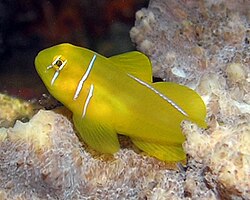Difference between revisions of "Gobiodon citrinus"
From The Aquarium Wiki
| (One intermediate revision by one other user not shown) | |||
| Line 49: | Line 49: | ||
== Diet == | == Diet == | ||
| − | :A | + | :A Carnivore, Eating such as brine shrimp, Mysis shrimp, and Blood Worms |
| Line 82: | Line 82: | ||
*[http://www.freshmarine.com/citron-clown-goby.html Fresh Marine] | *[http://www.freshmarine.com/citron-clown-goby.html Fresh Marine] | ||
*[https://www.saltwaterfish.com/product-citron-clown-goby-yellowfiji Saltwaterfish.com] | *[https://www.saltwaterfish.com/product-citron-clown-goby-yellowfiji Saltwaterfish.com] | ||
| + | *[http://eol.org/pages/213595/overview EOL] | ||
Latest revision as of 13:36, 12 September 2022
Citron Goby
Gobiodon citrinus
57 Litres (15 US G.)
3.8-5.1cm (1.5-2 ")
8.1 - 8.4
22.2-25.6°C (72 -78 °F)
8-12 °d
1:1 M:F
5-8 years
Family
Gobiidae
This animal is available captive bred
| You can contribute to the Aquarium Wiki by expanding this article. Dont be shy!. |
Contents
Additional names
- Clown Goby, Poison Goby
Origin[edit]
- Indo Pacific: found throut southern Japan, and Australia to the Red Sea.
Sexing[edit]
- It is very difficult to visually sex Citron Gobies.
Tank compatibility[edit]
- A generally peaceful fish, although may be territorial towards others of its own kind. This fish is reef-safe but may nibble at the base and polyps of Acropora corals.
Diet[edit]
- A Carnivore, Eating such as brine shrimp, Mysis shrimp, and Blood Worms
Feeding regime[edit]
- Feed once or twice a day depending on algae content of the tank.
Environment specifics[edit]
- Reef-safe and should not bother corals. Provide this fish with a mature tank with plenty of hiding places.
Behaviour[edit]
- A generally peaceful Goby that will spend its time in and around the live rock and will perch on ledges to survey its surroundings.
Identification[edit]
- Variable in colour from grey to brown-orange and head grey-blue. Iris is yellow and a yellow line runs from below eye to above axil. Several similar species and this one is best distinguished by the black spot on the caudal fin base.
Notes[edit]
- This species has a bitter-tasting mucous coating; this causes predators to spit it out, and avoid it in the future.
Pictures[edit]
External links[edit]
- Fishbase (Mirrors:
 )
)
